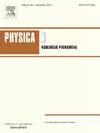增广KZ有限通量解与非局域共振转移
IF 2.7
3区 数学
Q1 MATHEMATICS, APPLIED
引用次数: 0
摘要
这篇短文是献给沃洛佳·扎哈罗夫的,他是一位独特而有独创性的科学家、领袖、导师、诗人和40多年来的好朋友。我们将在这篇文章的正文中更多地谈论这个人和他的工作。他对科学的众多和独特的贡献之一是发展了一种特殊的和极其相关的波浪湍流理论的解决方案,研究弱非线性,色散波的海洋的统计演化(Zakharov等人,1992)。描述谱能或数密度演化的封闭动力学方程已经为人所知多年,并于1962年由Hasselmann在表面重力波的背景下明确地推导出来(Hasselmann, 1962)。许多作品解决了自然闭合的问题(Benney and Saffman, 1966;Benney and Newell, 1969;Newell, 1968),其他的例子如罗斯比波(Longuet-Higgins and Gill, 1967),表面张力主导波(Zakharov and Filonenko, 1967),等离子体波(Vedenov, 1967)紧随其后。在Zakharov之前,除了动力学方程的解可能松弛的均分谱之外,没有太多关于统计稳态的讨论。守恒密度溶液的均分是明显的,通过检查很容易看到。但是,尽管许多西方作者都熟悉Kolmogorov在充分发展的流体动力湍流中的思想,Zakharov (Zakharov, 1965;Zakharov和Filonenko(1967)是唯一认识到在波浪湍流环境中也应该有统计稳态,对应于守恒密度的有限通量,如能量和波的作用,从它们被引入的尺度到它们被消散或吸收的尺度。动力学方程中隐藏着对称性,扎哈罗夫认为对称性应该存在,他也发现了。他们引导他得到了现在被称为Kolmogorov-Zakharov(或KZ)光谱的解。由于这些洞见,特别是对逆通量的发现,扎哈罗夫和克雷希南一起被授予2003年狄拉克奖章。然而,正如现任作者(Newell et al. 2001)所认识到的,这些解决方案在两个方面的有效性有限。首先,它们很少在整个光谱中普遍有效。其次,在某些情况下,与物理上重要的泛函相关的某些积分可能不收敛。术语非局部通常用于描述这种情况,但局部和非局部的定量定义仍然是开放的挑战。通俗地说,局部意味着主要的转移发生在相邻(在尺度上)波数之间;非局部意味着在广泛分离的尺度之间存在显著和直接的转移。KZ解包含了一些守恒密度的局部,一个级联,就像理查森(大漩涡产生小漩涡,以它们的速度为基础……)。在这篇短文中,我们将讨论这两个挑战的补救措施。首先,我们讨论了如何修复和增加波数区域中的KZ频谱,在这些区域中,由于实现闭合的前提被违反,KZ解不再得到。该决议可能有广泛的应用。它继续并实际上建立在其中一位作者和Zakharov (Newell and Zakharov, 2008)开始的大部分工作之上。第二个挑战解决了共振三和弦和四重奏成员之间发生重大共振转移的可能性和情况,这些成员的音阶非常不同。另一位作者(Balk等人,1990[13,14])已经在三波情境下研究了局部和非局部迁移的概念,最近在四波情境下,Korotkevich等人(2024)和Pan等人(2024)开始研究。在这项工作中,我们讨论了共振四重奏中的长波,短波配对是否可以解释在小尺度上由迈尔斯类型机制插入的海洋中的能量如何直接通过共振波包引发更长的波,或者更长的波是否产生于短暂的双级联,其中能量和波作用在一段时间内从小尺度流向大尺度。在我们所介绍的内容中,我们并不声称取得了任何重大突破,但希望我们已经开始了一些必要的对话。本文章由计算机程序翻译,如有差异,请以英文原文为准。
Augmenting KZ finite flux solutions and nonlocal resonant transfer
This short paper is dedicated to Volodja Zakharov, a unique and original scientist, leader, mentor, poet and great friend for more than forty years. We will speak more of the man and his work in the body of the paper. One of his many and singular contributions to science was the development of a special and extremely relevant class of solutions for wave turbulence theory, the study of the statistical evolution of a sea of weakly nonlinear, dispersive waves (Zakharov et al., 1992). The closed kinetic equation describing the evolution of the spectral energy or, equivalently, number density, had been known for many years, and had been explicitly derived in the context of surface gravity waves by Hasselmann in 1962 (Hasselmann, 1962). Many works addressing the questions of natural closure (Benney and Saffman, 1966; Benney and Newell, 1969; Newell, 1968), other examples such as Rossby waves (Longuet-Higgins and Gill, 1967), surface tension dominated waves (Zakharov and Filonenko, 1967), plasma waves (Vedenov, 1967) soon followed. Before Zakharov, there was not much discussion of the statistical steady states, other than the equipartition spectra, to which the solutions of the kinetic equation might relax. The equipartition of conserved density solutions were obvious, readily seen by inspection. But, despite the fact that many of the western authors were familiar with the ideas of Kolmogorov in fully developed hydrodynamic turbulence, Zakharov (Zakharov, 1965; Zakharov and Filonenko 1967) was the only one who realized that there should also be statistical steady states in the wave turbulence context corresponding to the finite fluxes of the conserved densities such as energy and wave action from scales at which they were introduced to scales at which they were dissipated or absorbed. The kinetic equation has hidden symmetries that Zakharov understood should be there and he found them. They led him to solutions that are now called Kolmogorov-Zakharov (or KZ) spectra. For those insights, and in particular for the discovery of inverse fluxes, Zakharov, along with Kraichnan, was awarded the 2003 Dirac Medal. However, as recognized by the present authors (Newell et al. 2001), these solutions have limited validity in two respects. First, they are rarely universally valid throughout the whole spectrum. Second, in some cases certain integrals, associated with physically important functionals, may not converge. The term nonlocal is often used to describe such situations but quantitative definitions of local and nonlocal remain open challenges. Colloquially, local connotes that the dominant transfer is between neighboring (in scale) wavenumbers; nonlocal connotes that there is significant and direct transfer between widely separated scales. KZ solutions connote local, a cascade, a la Richardson (big whirls make little whirls that feed on their velocity …), of some conserved density. In this short paper, we discuss remedies for these two challenges. First, we addresses how one may repair and augment the KZ spectrum in regions of wavenumbers where the KZ solution no longer obtains because the premises on which the closure is achieved are violated. The resolution may have broad applications. It continues and in fact builds on much of the work begun by one of the authors and Zakharov (Newell and Zakharov, 2008). The second challenge addresses the possibilities that, and situations where, significant resonant transfer occurs between members of the resonant triads and quartets which have very different scales. The notions of local and nonlocal transfer have been investigated in the three-wave context by the other author (Balk et al., 1990 [13,14]) and, recently in the four-wave context, begun in Korotkevich et al. (2024) and Pan et al. (2024). In this work, we discuss whether a long wave, short wave, pairing in a resonant quartet may explain how the energy in the sea, inserted by a Miles’ type mechanism at small scales, can initiate longer waves directly via resonant wavepackets or whether the longer waves arise from a transient dual cascade in which both energy and waveaction, for a time, flow from small to large scales. In what we present, we do not claim to have made any great breakthroughs but hope that we have begun several necessary conversations.
求助全文
通过发布文献求助,成功后即可免费获取论文全文。
去求助
来源期刊

Physica D: Nonlinear Phenomena
物理-物理:数学物理
CiteScore
7.30
自引率
7.50%
发文量
213
审稿时长
65 days
期刊介绍:
Physica D (Nonlinear Phenomena) publishes research and review articles reporting on experimental and theoretical works, techniques and ideas that advance the understanding of nonlinear phenomena. Topics encompass wave motion in physical, chemical and biological systems; physical or biological phenomena governed by nonlinear field equations, including hydrodynamics and turbulence; pattern formation and cooperative phenomena; instability, bifurcations, chaos, and space-time disorder; integrable/Hamiltonian systems; asymptotic analysis and, more generally, mathematical methods for nonlinear systems.
 求助内容:
求助内容: 应助结果提醒方式:
应助结果提醒方式:


